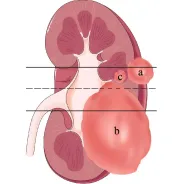Bosniak Calculator for Renal Cystic Masses
References:
- Warren KS, McFarlane J. The Bosniak classification of renal cystic masses. BJU Int. 2005;95(7):939-942. doi:10.1111/j.1464-410X.2005.05442.x
- Silverman SG, Pedrosa I, Ellis JH, et al. Bosniak Classification of Cystic Renal Masses, Version 2019: An Update Proposal and Needs Assessment. Radiology. 2019;292(2):475-488. doi:10.1148/radiol.2019182646
Related Calculators:
More about the Bosniak Calculator for Classification of Renal Cystic Lesions
The Bosniak Calculator is a decision-support tool designed to assist radiologists, urologists, and other healthcare providers in the systematic evaluation of cystic renal masses. Based on the 2019 update to the Bosniak classification system, this calculator incorporates contemporary imaging criteria to provide a more accurate, reproducible, and clinically meaningful assessment of renal cysts. The Bosniak calculator leverages cross-sectional imaging data to determine the appropriate Bosniak category and suggest appropriate follow-up or intervention strategies.
What Is the Bosniak Classification of Renal Masses?
The Bosniak classification is a standardized system used to categorize cystic renal lesions detected on CT or MRI scans. Initially developed in the 1980s and later revised in 2005 and 2019, the system stratifies lesions into five categories—Class I, II, IIF, III, and IV—based on morphological features such as wall thickness, septations, calcifications, nodularity, and enhancement patterns. These classifications help determine the likelihood of malignancy and inform clinical decision-making, including the need for surveillance or surgical intervention.
Purpose of Bosniak Calculator
The primary objective of this tool is to simplify the application of the Bosniak v2019 criteria by allowing users to input specific imaging findings and receive an evidence-based classification. It aims to reduce variability among radiologists, increase diagnostic confidence, and improve interdisciplinary communication regarding patient care.
Classification Criteria: 2019 Revision
The 2019 revision introduced clearer definitions, updated imaging thresholds, and enhanced reproducibility across readers and institutions. Below is a breakdown of the Bosniak categories as defined in the v2019 update:
- Class I:
- Simple cyst with a thin (≤2 mm), smooth wall
- Contains homogeneous simple fluid (CT: -9 to 20 HU; MRI: CSF-like signal)
- No septa, calcifications, or nodularity
- Wall may enhance, but no enhancing solid components
- Class II:
- Thin smooth wall with 1–3 thin septa (≤2 mm)
- Wall and septa may enhance slightly after contrast
- Calcifications may be present in any form
- May have hyperdense content or signal variation but no enhancement
- Class IIF:
- Slightly thickened wall (up to 3 mm) with or without enhancement
- Four or more smooth, thin (≤2 mm) enhancing septa
- No measurable nodularity or enhancing solid components
- Requires periodic follow-up imaging to monitor for changes
- Class III:
- Wall or septa show measurable thickening (≥4 mm) or irregularity
- May contain convex protrusions with obtuse angles
- Intermediate risk of malignancy—surgical consultation often warranted
- Class IV:
- Contains one or more measurable enhancing nodules
- Convex protrusions ≥4 mm with obtuse margins, or any protrusion with acute margins
- High suspicion for malignancy—surgical intervention typically indicated
How to Use the Bosniak Calculator
- Step 1: Select Imaging Modality
Choose whether the renal lesion was evaluated using contrast-enhanced CT or MRI. The Bosniak system has criteria applicable to both modalities. - Step 2: Input Imaging Features
Enter specific characteristics such as number and thickness of septa, presence and size of nodules, wall features, and enhancement patterns. The Bosniak calculator uses these inputs to classify the lesion. - Step 3: Receive Bosniak Classification
Based on your entries, the tool will generate a classification (I to IV), along with a brief description of its implications. - Step 4: Apply Results to Patient Care
Use the Bosniak category to help determine appropriate next steps: routine follow-up, repeat imaging, or referral for surgical evaluation. Always incorporate the patient’s clinical context and comorbidities in your final decision-making process.
Clinical Significance of Bosniak Categories
Each category in the Bosniak system correlates with an estimated risk of malignancy:
- Class I and II: Virtually no risk of malignancy. No further workup required.
- Class IIF: Indeterminate risk. Requires serial imaging to assess for progression.
- Class III: ~50% malignancy risk. Consider surgical consultation.
- Class IV: >90% malignancy risk. Surgical excision usually recommended.
Important Notes and Limitations
The Bosniak calculator is intended for use in general adult populations and is not validated for use in patients with known hereditary syndromes such as von Hippel-Lindau disease or tuberous sclerosis. Interpretation of complex renal cysts should always take into account the entire clinical picture, including patient history, symptoms, and other diagnostic findings.
While the Bosniak classification has high clinical utility, it is not infallible. Radiologist expertise, quality of imaging, and interdisciplinary collaboration all play key roles in accurate diagnosis and effective patient management.
References and Further Reading
- Silverman SG et al. "Bosniak Classification of Cystic Renal Masses, Version 2019: An Update Proposal and Needs Assessment." Radiology. 2019.
- American College of Radiology Appropriateness Criteria for Renal Mass Evaluation
- European Association of Urology Guidelines on Renal Tumors



